A Step-by-Step Look at Upper Endoscopy for GI Bleeding
Published: Sep 03, 2023
Upper endoscopy is a crucial procedure for diagnosing and managing upper GI bleeding. Here's how it works, step by step.
Contents
Preparing for the Procedure
Before an upper endoscopy, patients are advised not to eat or drink for several hours. This fasting ensures a clear view of the stomach and intestines. Medications like proton pump inhibitors may be given to reduce stomach acid and improve visibility.
The Endoscopy Process
During the procedure, a flexible tube with a camera is inserted through the mouth to examine the upper digestive tract. This allows doctors to identify bleeding sources and, if necessary, perform interventions to stop the bleeding, such as cauterization or clipping.

After the Endoscopy
Post-procedure, patients may experience mild throat discomfort or gas. They are usually monitored for a short period before being discharged. Follow-up care often includes medication adjustments and dietary recommendations.
Frequently Asked Questions
It's a procedure using a camera to examine the upper digestive tract.
Patients should fast for several hours before the procedure.
A tube with a camera is used to identify and treat bleeding sources.
Key Takeaways
Upper endoscopy is a vital tool in diagnosing and treating GI bleeding effectively.
Want to know if an endoscopy is right for you? Consult Doctronic for expert advice.Related Articles
References
Hwang JH, Fisher DA, Ben-Menachem T, et al. The role of endoscopy in the management of acute non-variceal upper GI bleeding.
Laine L, Barkun AN, Saltzman JR, et al. ACG Clinical Guideline: Upper Gastrointestinal and Ulcer Bleeding.
Always discuss health information with your healthcare provider.